In a world dominated by chatbots and text messaging, you might think phone calls are becoming a thing of the past. But many customers still prefer calling businesses over the phone to resolve their problems.
As a business owner, answering phone calls may not be your top priority. So it makes more sense for you to invest in an inbound call center instead.
Inbound call centers can receive calls on your company’s behalf. They can also provide tech support, order processing, appointment scheduling, and many other services — freeing up time for you to focus on growing your business.
In this article, we’ll explain what an inbound call center is and how it differs from an outbound call center. We’ll also highlight the most common call center services and the top five inbound call center software for your business.
This article covers:
(Click on a link below to jump to a specific section)
- What is an Inbound Call Center?
- 5 Common Inbound Call Center Services
- 4 Key Benefits of Inbound Call Centers
- Top 5 Inbound Call Center Software for 2021
Let’s get started.
What is an inbound call center?
An inbound call center (also known as a customer support center) focuses on receiving and acknowledging incoming calls from customers.
Inbound call center agents have to take customer calls and provide professional inbound customer service. The goal is to improve the customer experience, ensure caller satisfaction, and increase brand loyalty in the process.
On the other hand, the primary function of the outbound call center is to make outgoing calls to customers for sales or other services. You also have call centers that handle both incoming customer service inquiries and outgoing calls.
Let’s see how inbound call centers are different from outbound call centers.
Inbound vs. outbound call centers
Call centers fall into two main categories, depending on the service they provide:
1. Inbound call centers
Inbound call centers receive incoming calls from customers.
Usually, internal call center representatives can handle tech support, manage the helpdesk, process payments, follow-up on client queries, and more. They offer services for various industries, including healthcare, market research, insurance, banking, etc.
Your inbound call center agents can also function as virtual receptionists, fielding your company’s incoming calls and directing them to the appropriate person.
2. Outbound call centers
Outbound call centers make outgoing calls to potential customers for a specific purpose. You can also call this telemarketing.
With outbound call center services, the sales team makes outbound calls to existing or potential customers to inform them about new deals, products, reminders, or updates.
When deciding on the type of call center that’s best for your company, it’s essential to consider the primary goal of customer interactions. So let’s take a closer look at five types of customer interactions inbound call centers can help you manage.
5 common inbound call center services
These are some of the most popular inbound services for call centers:
1. Tech support
Inbound call center agents can help customers with various tech support issues.
From basic technical issues like password change and account information update to advanced technical support, the inbound call center team can help companies answer technical queries.
2. Order and payment processing
With the rise of e-commerce, the number of online shoppers is increasing every day.
Although most of them prefer to order through mobile or web apps, some customers still prefer to purchase items telephonically. They may also view items online and call in to place an order.
Alternatively, they may contact the company to solve payment and invoicing issues. An inbound call center can handle these phone calls to provide timely order and payment processing.
3. Appointment scheduling
Since Covid-19 caused many companies to close their doors, an efficient appointment setting system has become crucial.
Why?
Customers who want to speak to a company representative face-to-face can no longer just arrive at the business. They’ll have to contact the company call center first to book an appointment.
If appointment scheduling is quick and easy, it will increase customer satisfaction and customer loyalty. Your inbound call center agents can manage your company’s appointment scheduling to ensure that everything proceeds smoothly.
4. Inquiry management
Sometimes, your potential customers will call your company for information regarding your products or services.
An inbound customer service representative can guide customers through the products, services, and purchasing process. They’ll have the skills and experience to provide exceptional customer service to these consumers.
5. Complaint hotline
An inbound contact center can also handle customer complaints. The customer service representative needs to address these complaints carefully and provide a professional answering service.
You’ll need to handle customer problems effectively, or it will negatively impact your brand and company image.
4 key benefits of inbound call centers
Here’s how inbound call centers can benefit your business:
1. Better customer satisfaction
When your business process is customer-focused, you must ensure customer satisfaction and loyalty. Loyal customers will result in repeat business and are likely to recommend your services to their friends and family.
But for this, you need quality customer service. An inbound call center agent will understand your business needs to deliver a remarkable customer experience.
2. Cost savings
If your business has been impacted by the Covid-19 pandemic, having an inbound call center is a good idea. Customers can contact the call center instead of visiting your business in person. This way, you can downsize your business premises and cut down on real estate costs.
You can also save money by having call center agents work from home.
Additionally, if you decide to outsource your call center, you can save even more.
How?
Hiring your own customer service team can be costly — especially for small businesses. In addition to paying wages, you’ll also have to consider the time and resources it’ll take to train your inbound support services team.
With an in-house inbound center, you’ll have to pay full wages to every employee, even if the call volume is low.
On the other hand, you could consider call center outsourcing. This way, you get an experienced contact center team without the need for expensive recruitment drives, training, or having to pay high salaries and benefits.
Outsourcing companies are more cost-effective because you usually only pay for the calls that outsourced agents attend to.
Interested in call center outsourcing?
Go through this seven-step checklist to call center outsourcing.
3. Increases sales
Today, many customers prefer to place orders online or telephonically instead of in person. Customer expectations have also grown because of the increase in options customers have.
Your call center’s inbound sales agents can provide a convenient way for customers to place orders over the phone. Having a structured and effective inbound call center team can help improve customer satisfaction and increase sales.
Keep in mind that convincing an existing customer to try your new offerings is simpler than attracting a new one. After solving their queries, the inbound customer service representative can inform the customer about your new product offering — which can help boost sales.
4. Improves productivity
As a small business owner, you and your team have to be as productive as possible.
Your core employees should spend their time on activities that can grow your business and not only handle customer complaints. For example, your sales associates shouldn’t be doubling as customer service representatives and address complaints.
An inbound call center team can manage issues that your current in-house team doesn’t have time to handle. This way, you can keep customers happy while maintaining a high level of productivity among your employees.
Top 5 inbound call center software for 2021
To streamline inbound call center operations and boost agent efficiency, you can leverage call center software that fits your needs best.
Here are some of the top call center solutions suitable for inbound call centers:
1. Nice CXone
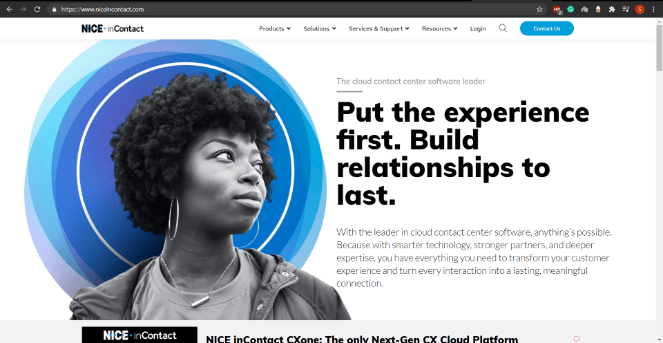
Nice CXone is a cloud-based call center platform that helps with lead generation and customer experience. It connects businesses with customers through various channels like inbound calls, outgoing calls, email, live chat, and social media.
A. Key features
- Omnichannel routing helps connect customers with agents across any communication channel.
- Analyze structured and unstructured data coming from all customer interactions
- Interactive voice response (IVR) and self-service options that can answer customers’ common questions.
- Optimize your workforce with the help of CXone WFO applications.
- Integrates with popular CRM applications like Salesforce and Zendesk.
B. Pricing
Contact support team for custom pricing.
C. Customer ratings
- G2: 4.3/5 (1100+ reviews)
- Capterra: 4.2/5 (450+ reviews)
2. Talkdesk
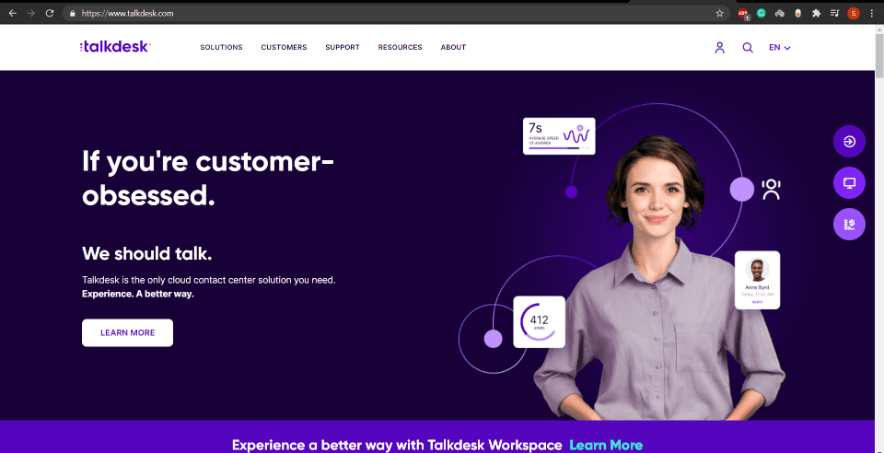
Talkdesk is a cloud-based contact center solution that helps companies improve customer interaction. They provide an artificial intelligence (AI) based unified communications platform.
A. Key features
- Manage every customer relationship with an all-in-one digital customer engagement solution, including messaging apps, SMS, social media channels, and chatbot functionality.
- Boost your workforce management with an integrated user experience for training, managing, and empowering your agents.
- Automatic call distributor (ACD) to route inbound calls to the right agent.
- Leverage real-time performance data and customer feedback surveys to improve customer satisfaction.
- Increase agent productivity by integrating with other business tools like Zendesk and Slack.
B. Pricing
Talkdesk’s pricing plan starts at $65/user per month.
C. Customer ratings
- G2: 4.4/5 (1200+ reviews)
- Capterra: 4.6/5 (40+ reviews)
3. Zendesk
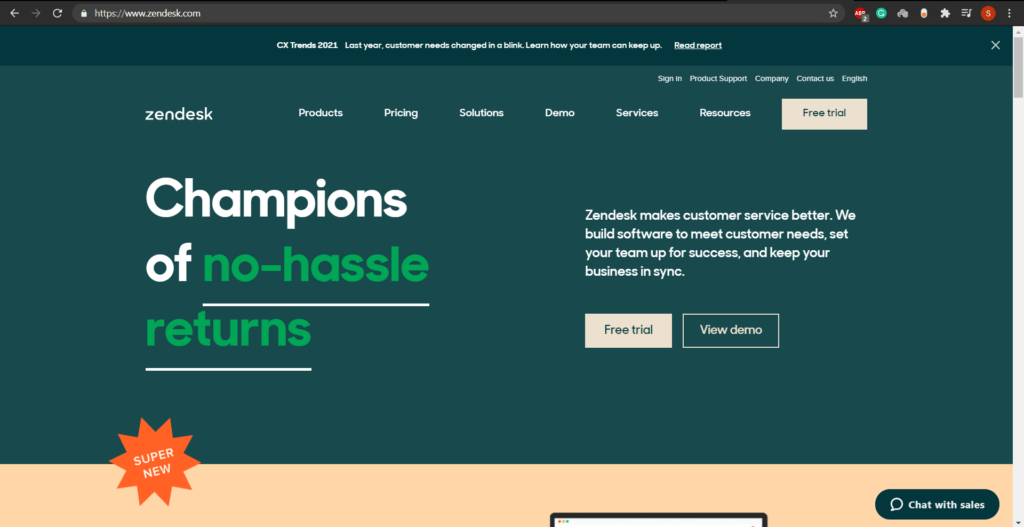
Zendesk is a cloud-based customer service program to improve engagement between customers and companies. Your customers can interact with multiple channels like email, phone, or social media applications.
A. Key features
- Keep a record of all the previous conversations using the Zendesk Talk voice solution.
- Create a personalized customer experience with Zendesk’s live chat tool on the web, app, or other social media platforms.
- Analyze, collect and measure the automatically generated user feedback to improve user experience.
- Improve sales with the help of its modern sales solution.
- Integrates with other CRM solutions so that agents get the full context of customer interactions.
B. Pricing
Zendesk’s pricing plan starts at $49/user per month.
C. Customer ratings
- G2: 4.2/5 (2500+ reviews)
- Capterra: 4.3/5 (2500+ reviews)
4. UJET
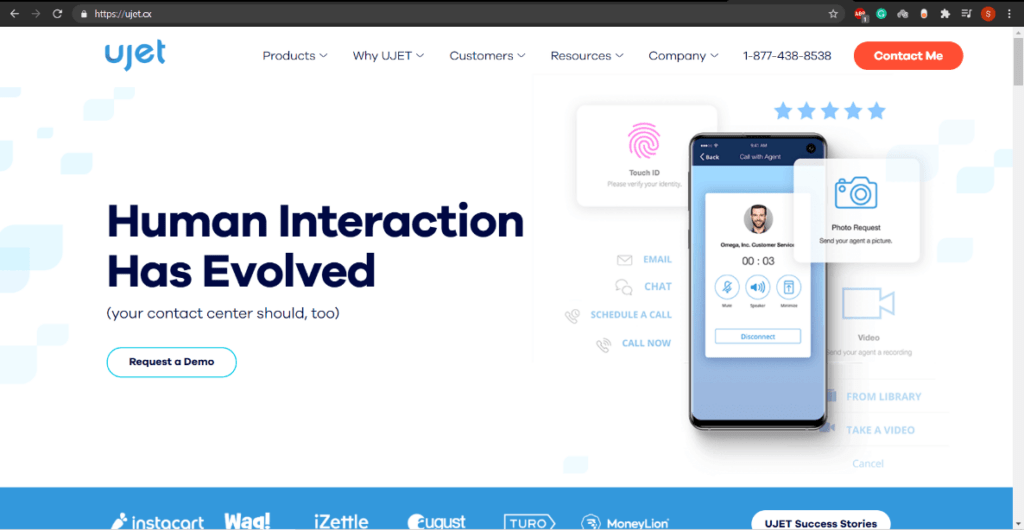
UJET is a cloud contact center platform designed specifically for customers using smartphones.
UJET integrates the enterprise brand experience across sales, marketing, and customer support, eliminating the frustration of using multiple channels.
A. Key features
- Streamline your customer journey by integrating voice and digital channels.
- Improve customer care and operational efficiency by introducing a virtual chatbot on your website.
- Access the UJET’s cloud-based contact center platform from anywhere. All the necessary tools and information are available through a single browser tab.
- Automatic ticket management helps boost agent productivity.
- UJET offers integrations with other call center software like Salesforce and Zendesk.
B. Pricing
Contact sales for a custom quote.
C. Customer ratings
- G2: 4.7/5 (540+ reviews)
- Capterra: 4.5/5 (100+ reviews)
5. Aircall
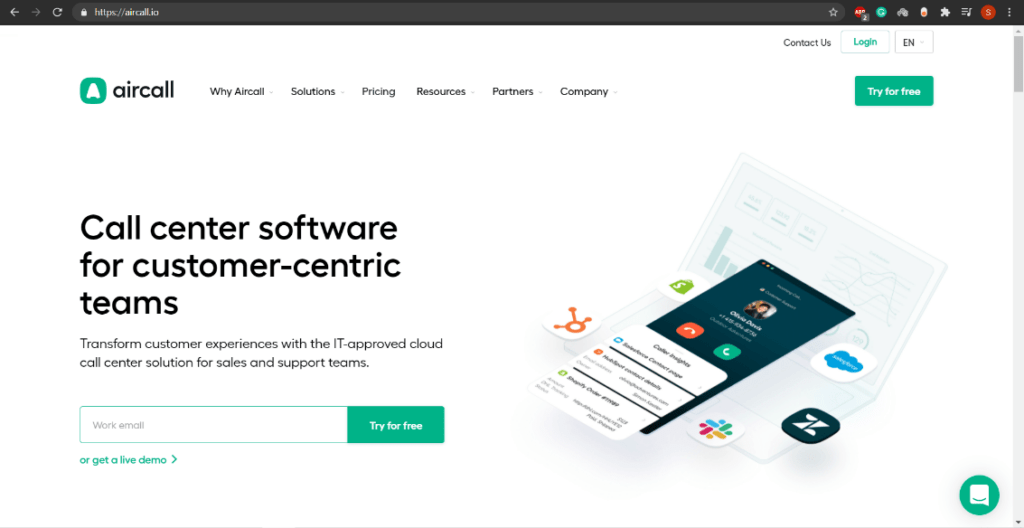
Aircall is a cloud-based call center program that helps to streamline customer support and sales management operations.
A. Key features
- Create IVR menus and routing rules to distribute inbound calls to the right agent.
- Monitor and analyze individual as well as team metrics to make significant improvements.
- Book meetings and close deals quicker with powerful features like auto-dialer, click-to-dial, real-time coaching, and more.
- Compile a list of numbers and make calls in a click using Aircall’s predictive dialer.
- Quickly integrate with other CRM applications like Salesforce, Pipedrive, and Slack.
B. Pricing
Aircall’s paid plans start at $30/user per month.
C. Customer ratings
- G2: 4.3/5 (400+ reviews)
- Capterra: 4.3/5 (200+ reviews)
Final thoughts
Whether you opt for business process outsourcing (BPO) or in-house customer support, customer service in 2021 is more than a traditional call center agent asking scripted questions before coming to a resolution (or sometimes not!).
Today, it’s a way to increase sales and improve client retention. That’s why you need to invest in a top-quality inbound call center.
After reading this guide, you should have a good idea of what an inbound call center is and how to create a consistent, smooth customer experience. And with the right tools, you’ll be able to streamline inbound call center operations with ease.

Andy is a technology & marketing leader who has delivered award-winning and world-first experiences.


